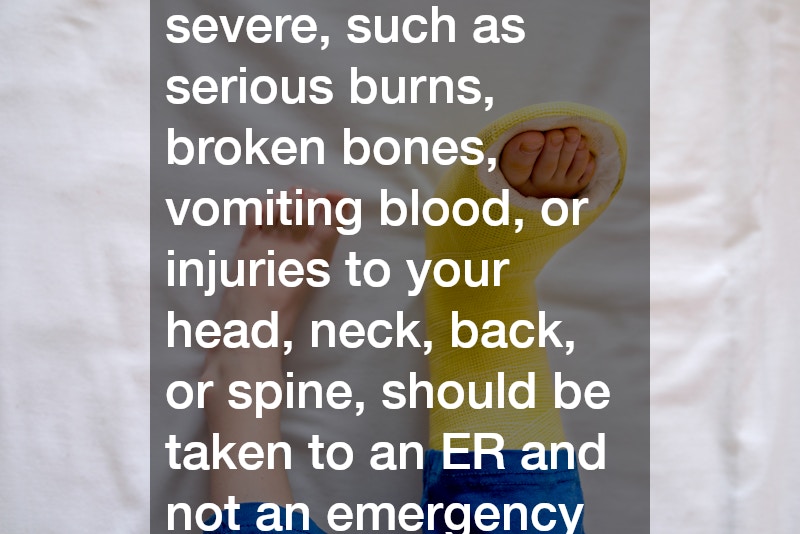
A few things are certain in life: death, taxes, and waiting hours in a hospital ER to be seen by a doctor for a medical condition. The number of urgent care clinics is rising nationwide, which helps lower the burden on hospitals and allows high-risk patient(s) to be seen at emergency clinics for various conditions. The state of the condition matters, and if your situation is an abnormal condition or disease, you’ll be asked to go to the emergency room.

However, you should still visit your local urgent care center if you have the following:
• Shortness of breath could be from underlying factors such as heartache or allergy.
• Pain in the abdomen that could be stomach flu, food poisoning, or indigestion.
• Cold or flu symptoms such as sore throat, congestion, headaches, runny nose, chills, fatigue, and cough.
• A urinary tract infection (UTI)
• Strains and sprains so severe that you’re unable to put the total weight of your body on your leg or have a full range of motion in your wrists and joints.
• Small first or second-degree burns.
• Diarrhea, fever, or bloody stool.

Anything more severe, such as serious burns, broken bones, vomiting blood, or injuries to your head, neck, back, or spine, should be taken to an ER and not an emergency clinic.

Have you ever experienced a medical concern after regular office hours? What do you do? Do you run to the local emergency room, even if your medical concern is not quite an emergency? Do you wait to see your primary care physician, even though you are in pain right now? This is the primary reason that doctors walk in clinics were created. They fill a gap in the medical coverage that is needed. People can choose a middle option, ensuring that they receive the medical care that they need, in a timely manner. What types of concerns are appropriate for this middle medical care?
Cold and flu. There is no cure for the common cold or the flu. However, the symptoms can be managed for more comfort. There are also some strains of the cold that are bacterial, which can be helped with antibiotics. A doctors walk in clinic can provide the necessary relief from the symptoms or antibiotics, if the cold is diagnosed as bacterial. Approximately 85% of urgent care centers are open seven days a week, making them extremely convenient for the care of cold and flu symptoms.
Minor aches and pains. Sometimes we experience minor aches and pains that do not warrant a visit to the emergency room, but that you would rather not wait to make an appointment for. Some primary physician’s offices book out for weeks, making it a very long wait. Doctors walk in clinic can provide the necessary diagnostic testing for some of these aches and pains. Additionally, they can sometime provide recommendations for over the counter pain relief.
Care for sprains and fractures. It seems like the majority of sprains and fractures occur from accidents after business hours. With four out of five urgent care centers providing fracture care, doctors walk in clinics are a great place to go when an accident happens. Some urgent care centers even have the capability of offering imaging to assess if something is broken or not. Doctors for urgent care can also offer follow up care directions.
Sinus and respiratory infections. The most common diagnosis in an urgent care center was upper respiratory condition, and the most common procedure was wound repair in 2012. Sinus and respiratory infections can cause a lot of discomfort and negative symptoms. It can result in loss of work or school. Although there may be no cure for these infections either, many patients prefer to ask the doctors about their symptoms. They prefer to receive a diagnosis and to get recommendations of over the counter sinus medications.
Slips and falls. Slips and falls are common, especially in those over the age of 60. Even if the person who slipped does not feel any pain, it is possible that damage was done. When an elderly person slips and falls, it is best to have them looked at by the best doctors. Medical patients can review doctors ratings of specific urgent care centers, to ensure that they are receiving the best medical care. An urgent care center can be a quick and easy way to have someone inspected after a slip and fall, without having to wait long hours at the local emergency department.
For many years, there was a medical coverage gap. When an accident or illness occurred after regular physician office hours, you either had to visit your local crowded emergency room, or wait until your physician?s office could fit you in. Urgent care centers have filled that gap, offering people quick medical care, without the long wait. The convenient hours of urgent care centers also make them perfect for those experiencing pain or illness symptoms late in the evening or on the weekends.

